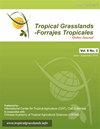半干旱南非退化公共牧场短期禁牧对土壤和草层的影响及其对恢复和牧场利用的影响
IF 0.7
4区 农林科学
Q3 AGRICULTURE, DAIRY & ANIMAL SCIENCE
引用次数: 3
摘要
在3种半干旱土壤类型[浅红色石质地(SRSG);浅,暗砂壤土(SDSL);和深而暗的粘土壤土[DCL]。所有土壤类型封育区牧草产量分别比连续放牧区高出98% (SRSG)、128% (SDSL)和152% (DCL)。放牧区收获的牧草酸性洗涤纤维(P≤0.001)和酸性洗涤木质素(P<0.05)含量均高于放牧区。在SRSG和SDSL土壤中,放牧收获的牧草样品磷(P)缺乏。不同土壤类型,封育区土壤镁、有机碳、氮、磷和锰含量显著高于连续放牧区(P≤0.05)。由于缺乏放牧,灌丛中落叶提供的营养物质的任何反应都不能与反应分开,这值得进一步研究。我们的研究结果表明,在这些半干旱的牧场上,短期(2年)不放牧可以使牧场产生显著的生长,表明牧场仍然具有生产力。我们的经验突出表明,由于盗窃,在设置和保留传统围栏以防止牲畜进入特定地区的困难。植被恢复后立即放牧可能需要明智的营养干预,补充蛋白质、能量和矿物质,以有效利用可利用的牧草。本文章由计算机程序翻译,如有差异,请以英文原文为准。
Short-term grazing exclusion impacts using brush packs on soil and grass layers in degraded communal rangelands of semi-arid South Africa and implications for restoration and pasture utilization
Brush packs from very thorny tree branches were used to simulate grazing exclosures to measure differences in herbaceous vegetation and soil characteristics over 2 years on small ungrazed plots and large continuously grazed communal rangelands on 3 semi-arid soil types [shallow, red stony ground (SRSG); shallow, dark sandy loam (SDSL); and deep, dark clay-loam (DCL)]. Pasture presentation yields within exclosures exceeded those on continuously grazed areas for all soil types by: 98% (SRSG), 128% (SDSL) and 152% (DCL). Herbage samples harvested from the exclosures contained higher acid detergent fiber (P≤0.001) and acid detergent lignin (P<0.05) concentrations than those from the grazed areas. In SRSG and SDSL soils, herbage samples harvested from the exclosures were deficient in phosphorus (P) for all livestock species. Depending on soil type(s), soil magnesium, organic carbon, nitrogen, P and manganese concentrations were significantly higher within exclosures than in continuously grazed areas (P≤0.05). Any response from nutrients supplied by leaf drop from the brush packs could not be separated from response due to absence of grazing, and this deserves further investigation. Our results indicate that grazing exclusion for short periods (2 years) on these semi-arid rangelands allowed pastures to produce significant growth, demonstrating that pastures were still productive. Our experiences highlighted the difficulties in erecting and retaining conventional fences to exclude livestock from given areas because of theft. Grazing immediately after vegetation recovery may necessitate judicious nutritional intervention with protein, energy and mineral supplementation to get effective utilization of the available forage.
求助全文
通过发布文献求助,成功后即可免费获取论文全文。
去求助
来源期刊

Tropical Grasslands-Forrajes Tropicales
Agricultural and Biological Sciences-Agronomy and Crop Science
CiteScore
1.60
自引率
0.00%
发文量
36
审稿时长
16 weeks
期刊介绍:
The Journal publishes, in English or Spanish, Research Papers and Short Communications on research and development, as well as contributions from practitioners (Farmer Contributions) and Review Articles, related to pastures and forages in the tropics and subtropics. There is no regional focus; the information published should be of interest to a wide readership, encomprising researchers, academics, students, technicians, development workers and farmers.
In general, the focus of the Journal is more on sown (''improved'') pastures and forages than on rangeland-specific aspects of natural grasslands, but exceptions are possible (e.g. when a submission is relevant for a particularly broad readership in the pasture and forage science community).
The Journal will also consider the occasional publication of associated, but closely related, research in the form of an additional scientific communication platform [e.g. a re-make of the former Genetic Resources Communication series of the former Division of Tropical Crops and Pastures of the Commonwealth Scientific and Industrial Research Organisation (CSIRO), Australia].
Areas of particular interest to the Journal are:
Forage Genetic Resources and Livestock Production[...]
Environmental Functions of Forages[...]
Socio-economic Aspects[...]
Topics within the aforementioned areas may include: Diversity evaluation; Agronomy; Establishment (including fertilization); Management and utilization; Animal production; Nutritive value; Biotic stresses (pests and diseases, weeds); Abiotic stresses (soil fertility, water, temperature); Genetics and breeding; Biogeography and germplasm collections; Seed production; Ecology; Physiology; Rhizobiology (including BNF, BNI, mycorrhizae); Forage conservation; Economics; Multilocational experimentation; Modelling.
 求助内容:
求助内容: 应助结果提醒方式:
应助结果提醒方式:


